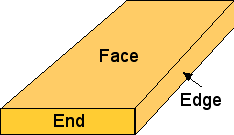I have worked in furniture shops in the United States, and learned to call the exposed surface of a cross-sectional cut called endgrain, sometimes spelled with a space, "end grain":
Endgrain is exposed when timber is cut across the annual growth rings at 90 degrees rather than cutting a plank of wood along the length of the tree. This type of cut exposes the internal character and mechanics of a tree to reveal a highly attractive and durable surface. (endgrain.org.uk)
A wood-working technique has a direction relative to the wood grain; one of these directions can be described "end grain" (or "cross-grain"):
end grain (at right angles to the grain, for example trimming the end of a plank) (Wikipedia)
The first thing that I think of in relation to endgrain, because of many hours spent sanding and varnishing by hand, is the fact that it absorbs much more sealer, paint or varnish than the "side grain" when finishing it. Here is one way to reduce this difference:
Simply sand the end and edge grains to one higher grit than the side grain. So if you sand the side grain to 150, sand the end grain to 220; if the side is 220, the end and edge grains should be 320 and so forth. This makes the uniform roughness (which is really what sandpaper accomplishes) of the end grain smaller, where it soaks up less finish. (bobvila.com, emphasis added)




